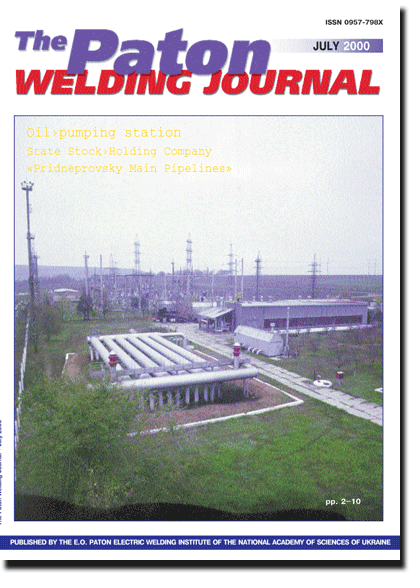

|
PATON B.E., SEMENOV S.E., RYBAKOV A.A., VASILENKO S.K. and
VASILYUK V.M. Ageing and procedure of evaluation of the state of metal of the main pipelines in service |
2 |
| Basic concepts of ageing of metal of the line pipelines in use for a long time are formulated proceeding from up-to-date knowledge and available experimental data. The principles of classification of the state of the pipeline materials, allowing for the service effects, are suggested. | |
|
POKHODNYA I.K., SHVACHKO V.I. and PORTNOV O.M. Mathematical modelling of absorption of gases by metal during welding |
21 |
| Results of mathematical modelling of absorption of hydrogen and nitrogen by iron during welding are presented. The kinetic model of interaction of the low-temperature plasma with metal, based on the combined solution of equations of mass traasfer in gas and metal, has been developed. Comparison of calculation results and experimental data shows that the model developed adequately describes absorption of two-atomic gases by metal. The process of absorption of gases by the molten metal pool from the low-temperatire plasma has been calculated. The above model allowed the effect of the plasma temperature on the concentration of gas dtMolWfii in metal to be estimated. | |
|
EFIMENKO N.G. and KALIN N.A. Thermodynamic analysis of redox carbon-involving processes occurred during fusion welding |
17 |
| The article suggests an approach to thennodynamic calculation of chemical reactions proceediDg in three phases, i. e. metal, slag and gas, at the same temperature. Series of the probable proceeding of reactions of oxidation of elements and reactions of carbon reduction of elements from oxides have been arraagwl for characteristic temperatures of the melting zone in arc welding. It is shown that temperature of beginning of carbon reduction of oxides in the metal phase, except CeO2, and FeO, is lower than that in the slag phase which allows the deoxidation process to occur at lower temperatures and provides the possibility of using carbon in a bound state as a deoxidizer in welding consumables, | |
|
KROSHINA G.M., VASILIEV V.G. and NOVIKOVA D.P. Peculiarities of phase and structural transformations occurring in gray cast irons with a differing phosphorus content during thermal-deformation welding cycle |
21 |
| Phase and structural transformations in commercial cast iron SCh20 with a phosphorus content of 0.10 and 0.28 % during welding have been investigated. The effect of the thermal-deformation welding cycle on deformability of cast irons has been studied. Continuous cooling transformation diagrams for austeoite have been plotted. It is shown that an increased phosphorus content of gray cast iron favours development of an intermediate transformation of austenite in the HAZ metal. Peculiarities of behaviour of phosphide eutectic during the thermal-deformation welding cycle have been investigated. | |
|
NAZARCHUK A.T. Improvement of process of consumable electrode welding with an intermittent arc |
28 |
| Some basic schematics are analyzed of stabilization of arc excitation and running in metal-electrode arc welding with weld formation in portions, in particular using a low-amperage arc. Shown is the rationality of making up the welding circuit of several independently controlled loops which provide the conductance of the arc gap, main arc running, control of the capacitor discharge in the arc gap by means of capacitive or inductive contours connected directly into the welding circuit. | |
|
BERNATSKY A.V. Influence of anisotropy of the rolled stock mechanical properties on initiation and development of tough and lamellar-tough fractures |
31 |
| Brief description of expert estimations of service failures related to the structural texture, is given. The rationality of introduction of new terminology is presented in order to define the main kinds of lamellar fracture, namely lamellar-tough, lamellar-brittle, lamellar-fatigue and lamellar-hydrogen. A quantitative estimate of the influence of the percentage of sulphur in the base metal on the process of initiation and development of tough and lamellar-tough fractures, is given. | |
|
KIRILYUK G.A. and LEVCHENKO O.G. Hygienic evaluation of process of arc metallizing with flux-cored wire of Fe-B-Cr-Ni alloying system |
38 |
| Quantitative characteristics of aerosols evolution in flux-cored wire arc metallizing of alloyed alloys are determined and recommendations are given on protection of workers and environment. | |
| PWI TECHNOLOGIES | 40 |
| ADVERTISING | 51 |
__
(You are viewing the simplified file contents)
The cost of subscription/purchase order journals or individual articles
| Journal/Currency | Annual Set | 1 issue printed |
1 issue |
one article |
| TPWJ/USD | 384 $ | 32 $ | 26 $ | 13 $ |
| TPWJ/EUR | 348 € | 29 € | 24 € | 12 € |
| TPWJ/UAH | 7200 UAH | 600 UAH | 600 UAH | 280 UAH |
| AS/UAH | 1800 UAH | 300 UAH | 300 UAH | 150 UAH |
| AS/USD | 192 $ | 32 $ | 26 $ | 13 $ |
| AS/EUR | 180 € | 30 € | 25 € | 12 € |
| SEM/UAH | 1200 UAH | 300 UAH | 300 UAH | 150 UAH |
| SEM/USD | 128 $ | 32 $ | 26 $ | 13 $ |
| SEM/EUR | 120 € | 30 € | 25 € | 12 € |
| TDNK/UAH | 1200 UAH | 300 UAH | 300 UAH | 150 UAH |
| TDNK/USD | 128 $ | 32 $ | 26 $ | 13 $ |
| TDNK/EUR | 120 € | 30 € | 25 € | 15 € |
AS = «Automatic Welding» - 6 issues per year;
TPWJ = «PATON WELDING JOURNAL» - 12 issues per year;
SEM = «Electrometallurgy Today» - 4 issues per year;
TDNK = «Technical Diagnostics and Non-Destructive Testing» - 4 issues per year.


